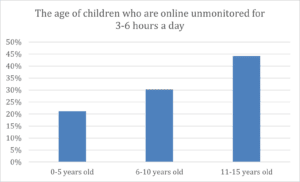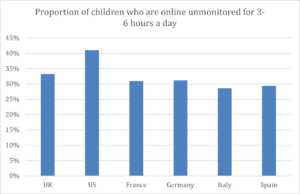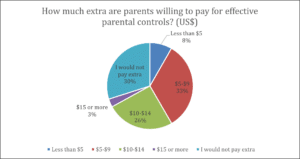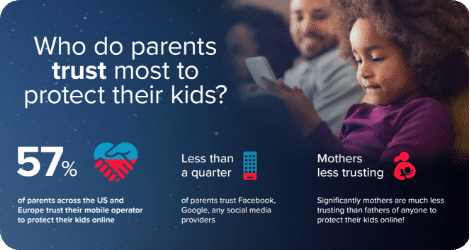Parents Want Operators to Safeguard Their Children – and Are Willing to Pay Extra
Remember the term ‘screen time’? You’d be forgiven for letting that definition slip through your fingers – given the events of the past year. Screen time appeared to lose all meaning in 2020. We all cut ourselves – and our children – some slack for spending way more time on mobile devices than usual. However, where the impact of screen time on our children is difficult to measure and relatively innocuous, access to the internet can cause untold harm to our young ones if left unchecked and unsupervised.
In an age with billions of connected devices, screens are an unavoidable gateway to the online world. So how has the pandemic impacted our kids’ activities online, and who can supervise them when they’re exposed to online harm? That is what we set out to find out with a pioneering international survey.
The scale of the problem

We commissioned Censuswide to interview more than 4,000 parents in the US, UK, France, Germany, Italy and Spain to assess the impact of lockdown on their children’s online activity. Unsupervised mobile activity was a headache for parents of children of all ages.
44% of those aged 11-15 and 30% of those aged 6-10 spent between 3 and 6 hours browsing the internet unsupervised every day during lockdown. Even parents of those aged 5 and under reported their youngsters spending at least an hour a day unsupervised on a mobile device.
These issues seemed most prevalent in the US, where the proportion of children across all age groups spending 3-6 hours per day online unmonitored was at its highest at 41%. The UK was close behind at 33%, with France, Germany, Italy and Spain all hovering around the 30% mark.

Is unsupervised access to the mobile internet for our kids becoming a pandemic in and of itself? If so, what can be done about it and whose responsibility is it?
According to UNICEF, more than 185 countries around the world closed their schools at some point during the pandemic, forcing millions of students to take over the kitchen table at home and move their studies online. It’s hardly fair to expect parents to home-school their children and monitor their every move online while they themselves attempt to carry on working through such turbulent times.
Nobody expects that.
So, the focus naturally turns toward technology such as parental controls, firewalls and other automated solutions that can keep children safe as they browse the internet. But who should provide these tools, how good are they, and how to parents feel about them?
Who do parents trust to safeguard children online?
In the same survey, we asked each parent who they’d most trust with the safeguarding of their children’s online activity. More than 80% said they’d absolutely welcome additional parental controls and safeguards, but there were some differing opinions when it came to sourcing these tools.
Less than a quarter of all those asked said they’d trust Google, Facebook or any other social media provider with their child’s online safety. An interesting side note was that mothers seemed to be less trusting than fathers of any third party when it came to protecting their children from harmful online content. So where do parents turn?
While the survey revealed an element of distrust toward third parties like Google and Facebook, nearly 6 in 10 (58%) parents said they’d be more than happy to pay $5 to $14 more per month to provide more effective safeguard controls for their kids.

Even more surprising, was that more than half (56%) of those asked said they would be willing to leave their current mobile network provider for one that offered better parental controls at the same price.
The role mobile network operators play in protecting children online
While there are many device-based parental control products available, most children are tech-savvy and can find ways to circumvent the safeguards on laptops and phone apps. However, the parental control solutions that are network-based are harder to by-pass and provide parents with robust safeguarding mechanisms. As such, mobile operators can play a pivotal role to protect vulnerable users on their network.
Of course, operators who want to deliver conventional parental controls solutions face obstacles placed by OTTs in the shape of encryption. As Gorkem Yigit, Principal Analyst at Analsys Mason points out: “Encryption protocols such as HTTPS and QUIC have made it more challenging for operators to stop inappropriate content reaching vulnerable users. And existing parental control solutions could be rendered obsolete due to the growing adoption of TLS 1.3 with encrypted SNI that will blind-side operators.”
So, how can operators overcome this? Deploy AI-based traffic classification systems that can instantly identify content based on statistical prediction, behavioral analysis and heuristics. This will help operators to deliver parental control solutions that are effective – now and well into the future.
Of all the things to compete over, child safety is certainly up there as one of the most wholesome and beneficial to society at large. Could mobile network operators soon become parents’ last and best line of defense when it comes to shielding their children from online harm?
Take a look at our infographic summarising the report:
7045 Parental-Controls Infographic v4
Download the full exclusive report on mobile operator parental controls






